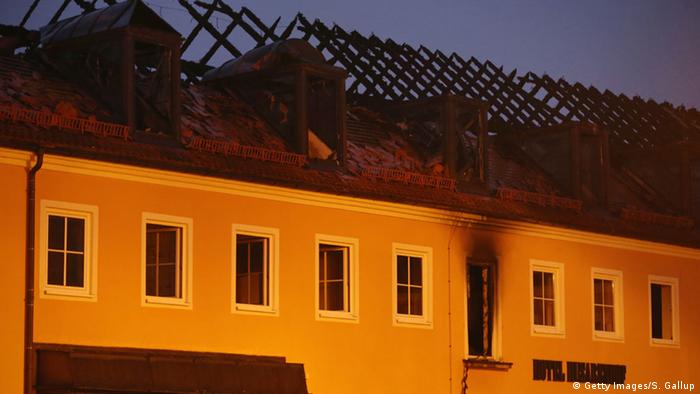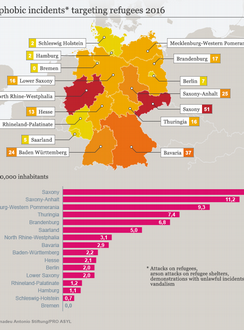Despite decreasing numbers of refugees in Germany, the number of crimes
on refugee accommodation shows no sign of waning. One of the German
Criminal Police Office's (BKA) main fears is an attack by a lone wolf.

According to a report from the BKA, the first quarter of 2016 saw 347
crimes linked to refugee accommodation. Among the offenses were three
attempted homicides, 37 arson attacks and 23 injuries. The whole of 2015
saw a total of 1,031 such crimes.
The figures - which were requested by police from Germany's 16 states
and published by German public broadcasters WDR and NDR, and the
Munich-based daily Süddeutsche Zeitung on Wednesday - are preliminary
and represent the so-called "police input statistics." To date,
investigating authorities estimate that
some 319 of the attacks on refugee homes were "right-wing motivated."
"Given the close ideological ties of the 'abuse of asylum debate' with
the classic right-wing agitation field of 'xenophobia,' it's assumed
that asylum seekers are increasingly among the targets of any violent
crime," the report said, warning that the violent crimes could also
result in deaths.
For the first time, the situation includes figures on attacks on
refugees, aid workers and so-called elected representatives. As a
result, the report found that in the first three months of 2016 there
were 73 violent right-wing crimes committed against refugees, including a
sexual assault.
More 368 right-wing offenses, related to vandalism, the spread of
propaganda, and hate speech, were also recorded, as well as an
increasing number of attacks on volunteers, politicians and journalists.
Eighty-eight such offenses targeted politicians or political leaders in
2016. Among the 33 cases of volunteers being targeted by right-wing
violence, two were recorded as being injured.
Concerns over radical groups
Although the BKA hasn't detected a Germany-wide organized structure,
investigators said the founding of right-leaning terrorist or criminal
groups must be reckoned with. This was proven, the report said, not only
in the sharp increase in hospital admissions as a result of violent,
right-wing crime, but also due to "a high crime density in each region,
the number of classified instigator and relevant persons, the
availability of weapons or explosives and ever-increasing verbal radical
rhetoric."
The report released on Thursday also provides details on the suspects.
Of the 551 people charged with right-wing-motivated crime,
just 25 percent were convicted and only three people classified by state constitution protection agencies as "relevant persons."
The BKA's report confirms a trend reflected in figures published by the Antonio Amadeu Foundation and ProAsyl this year:

Fears of 'lone wolf' attacks
Earlier in April, German Interior Minister Thomas de Maiziere said the
last quarter had seen a decline in the number of refugees arriving in
Germany. Between December 2015 and March 2016, the number of monthly
arrivals decreased significantly from around 120,000 to 20,608.
However, despite the falling numbers of refugees, Thursday's report
found that there is no end in sight for agitation of Germany's
right-wing scene. On the contrary, hate-fueled, violent offenses against
the person are being promoted as part of the right's "climate of fear."
The report also noted that, compared to 2014, the proportion of female
suspects has also doubled.
One of the main fears of the BKA is the threat from a "resolute,
irrational acting, fanatical lone wolf," who has no connection to an
extremist groups. Police have yet to develop investigative approaches
and prevention strategies to avoid cases such as the stabbing of Cologne
mayor Henriette Reker last October.
No comments:
Post a Comment